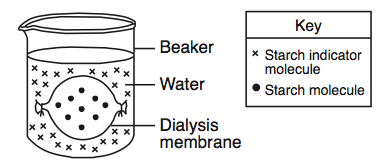4.1.Diffusion2

These questions deal with the diffusion lab that we just completed
REMEMBER: PERIOD # followed by FIRST & LAST NAME you must score at least a 70
- 1.
If frog eggs taken from a freshwater pond are placed in a saltwater aquarium, what will most likely happen?
- A.
Water will leave the eggs.
- B.
Salt will leave the eggs.
- C.
Water will neither enter nor leave the eggs.
- D.
The eggs will burst.
Correct Answer
A. Water will leave the eggs.Explanation
When frog eggs are placed in a saltwater aquarium, the concentration of salt in the surrounding water is higher than that in the eggs. This creates a concentration gradient, causing water to move out of the eggs through osmosis. As a result, the eggs will lose water and shrink. Therefore, the most likely to happen is that water will leave the eggs.Rate this question:
-
- 2.
Base your answers to this question on the experimental setup shown below. On the diagram below, where is the expected location of the starch after a period of one hour?
Correct Answer
inside
inside the bag
inside bag
inside onlyExplanation
The expected location of the starch after a period of one hour is inside the bag.Rate this question:
- 3.
Base your answers to this question on the experimental setup shown below. When starch indicator is used, what observation would indicate the presence of starch?
Correct Answer
color changes
color change to purple
color changes to blue black
color change to blue black
color changes to purple
color change
purple
blue blackExplanation
The presence of starch can be indicated by a color change in the solution. Specifically, if the color changes to purple or blue-black, it suggests the presence of starch.Rate this question:
- 4.
Base your answers to this question on the experimental setup shown below. State one reason why some molecules can pass through a certain membrane, but other molecules can not.
Correct Answer
too big
molecules are too large
molecules are too big
too large
too big to pass through
too large to pass throughExplanation
Some molecules cannot pass through a certain membrane because they are too big or too large in size. The size of the molecules determines their ability to pass through the membrane.Rate this question:
- 5.
Glucose indicator was added to a beaker of an unknown liquid. Starch indicator was added to a different beaker containing the same unknown liquid. The color of the indicator solutions before they were added to the beakers and the color of the contents of the beakers after adding the indicator solution are recorded in the chart below. Which carbohydrate is present in the unknown liquid?
Correct Answer
starch
starch onlyExplanation
The presence of starch indicator in the beaker containing the unknown liquid indicates the presence of starch in the liquid. The fact that the glucose indicator did not change color suggests that glucose is not present in the liquid. Therefore, the carbohydrate present in the unknown liquid is starch.Rate this question:
- 6.
A laboratory setup of a model cell is shown in the diagram below. Which observation would most likely be made 24 hours later?
- A.
The contents of the model cell have changed color.
- B.
The diameter of the model cell has increased.
- C.
The model cell has become smaller.
- D.
The amount of distilled water in the beaker has increased.
Correct Answer
B. The diameter of the model cell has increased. -
- 7.
Part of a laboratory procedure is shown in the diagram below. This setup would most likely be involved in a procedure to
- A.
Stain specimens while making a wet mount
- B.
Test for the presence of glucose using an indicator
- C.
Separate pigments in a mixture
- D.
Determine the pH of solutions
Correct Answer
B. Test for the presence of glucose using an indicatorExplanation
The setup shown in the diagram consists of a test tube containing a solution and a test strip or indicator. This setup is commonly used to test for the presence of glucose using an indicator. The indicator will change color in the presence of glucose, allowing the experimenter to determine if glucose is present in the solution. This setup is not typically used for staining specimens, separating pigments, or determining pH.Rate this question:
-
- 8.
A model cell setup is represented in the “Initial State” diagram below. Which diagram indicates the areas where each of these substances would be located after 20 minutes?
- A.
- B.
- C.
- D.
Correct Answer
C. -
Quiz Review Timeline +
Our quizzes are rigorously reviewed, monitored and continuously updated by our expert board to maintain accuracy, relevance, and timeliness.
-
Current Version
-
Mar 22, 2023Quiz Edited by
ProProfs Editorial Team -
Dec 04, 2011Quiz Created by
Ionca
- Air Quizzes
- Atmosphere Quizzes
- Beach Quizzes
- Biome Quizzes
- Climate Quizzes
- Desert Quizzes
- Disaster Quizzes
- Ecosystem Quizzes
- Evolution Quizzes
- Fire Quizzes
- Flower Quizzes
- Forest Quizzes
- Global Warming Quizzes
- Lake Quizzes
- Landform Quizzes
- Mountain Quizzes
- Natural Resource Quizzes
- Nature Of Matter Quizzes
- Plant Quizzes
- Pollution Quizzes
- Recycling Quizzes
- River Quizzes
- Sea Quizzes
- Season Quizzes
- Snow Quizzes
- Soil Quizzes
- Weather Quizzes
- Wildlife Quizzes
- Wind Quizzes
 Back to top
Back to top











